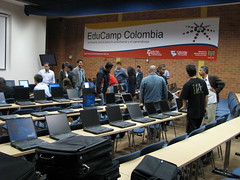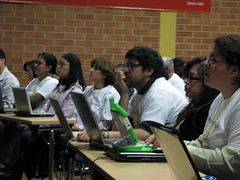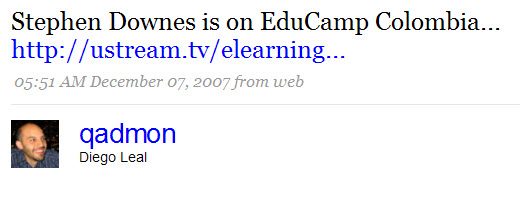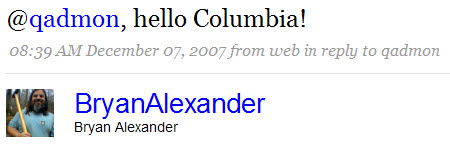Este es el tercer post de una serie de cuatro. Luego de la intensa actividad del primer Educamp, tal vez lo más sensato habría sido descansar un poco y continuar una semana después. No obstante, para no perder la costumbre de emprender cosas casi suicidas  , el taller de Medellín estaba programado para dos días después (el 7 de Diciembre de 2007).
, el taller de Medellín estaba programado para dos días después (el 7 de Diciembre de 2007).
Aprovechando lo aprendido
El día 6 llegamos a la ciudad, y justo después de dejar nuestro equipaje en el hotel nos dirigimos al Centro de Convenciones Plaza Mayor, en donde se realizó el evento.
La idea de la visita previa era no sólo conocer el espacio, sino trabajar un rato con los estudiantes que nos apoyarían en el desarrollo de la actividad. A diferencia de lo que había ocurrido en Bogotá, aquí se generó muy rápido un ambiente muy informal entre todos, lo que facilitó el trabajo que realizamos.
Sentados en el piso (pues no había sillas) y luego de presentarnos, expliqué en detalle qué era lo que esperábamos que ocurriera el día siguiente. A diferencia de Bogotá, le pedí a cada uno de ellos que trajera un computador portátil (de los que teníamos alquilados para el evento), y luego de identificar cuáles eran las fortalezas de cada uno (en cuanto a herramientas), hicimos un simulacro de aprendizaje entre pares. Por mi parte, me senté con dos de ellos (pues ninguno había utilizado twitter), e hice el ejercicio de crear usuarios y seguirnos entre nosotros, para mostrar cómo crear una red con esta herramienta. Luego, ellos se encargaron de mostrar a sus colegas cómo hacer esto mismo, con lo que quedó razonablemente clara cuál sería la dinámica del día siguiente.
Cuando terminamos y ellos se fueron a prepararse para el día siguiente, yo me quedé un largo rato en el auditorio (aprovechando que allí teníamos red) preparando algo que quería tener listo para el día siguiente: Se me ocurrió que sería interesante aprovechar el gran telón que teníamos en el auditorio (en donde se proyectarían las diapositivas de las presentaciones) para desplegar a lo largo del día una presentación automática que mostrara las herramientas sobre las que estaríamos trabajando. La idea de esto era tener un medio más para que los asistentes pudieran obtener más información a lo largo del día (esta presentación tomó mucho más tiempo del que yo esperaba, y de hecho la terminé en el hotel a eso de la 1:30 de la mañana  ).
).
Más allá del deber
Al día siguiente, las cosas empezaron de manera similar a Bogotá durante el registro. Pero una idea (que en realidad no se si fue de los estudiantes o de las personas de Cintel) agregó un elemento que no tuvimos en Bogotá: Nuestros estudiantes empezaron a entrevistar a algunas personas, preguntando sobre sus expectativas acerca del taller:
(Más entrevistas sobre expectativas se encuentran aquí, aquí, aquí, aquí y aquí)
Otra sorpresa esperaba a los asistentes, esta más inesperada. Desde el inicio, el auditorio no tenía la disposición organizada que tuvimos en Bogotá, sino que dispusimos sillas, sillones, mesas redondas de manera "desordenada". Así se veía durante la conferencia de Stephen (la misma que realizó en Bogotá):
Aprendiendo por encima del hombro
Una opinión sobre las charlas y lo que vendría más adelante:
(Idea: Puede ser útil contar con un backchannel en el cual los participantes puedan expresar sus ideas sobre las conferencias y reportar más adelante a todo el grupo qué han aprendido. Eso ayuda a visibilizar el logro de toda la comunidad. También puede usarse como "anuncio clasificado", para ubicar a personas de las que pueda aprender).
Luego de las conferencias, entramos de lleno al taller. Con las lecciones de Bogotá, se pudo garantizar un servicio de red óptimo, con lo cual no hubo obstáculos para el trabajo de los asistentes.
Como en Bogotá, mi impresión es que todo el contexto de ampliación del Ambiente Personal de Aprendizaje no fue lo bastante contundente como elemento articulador, pero eso es algo que trataré de mejorar en los siguientes talleres.
Hicimos algo más, a diferencia de Bogotá. Como la idea de las estaciones de herramientas funcionó bastante bien, decidimos en esta oportunidad ofrecer tres posibilidades de aprendizaje:
- Si usted quiere explorar por su cuenta, use la hoja de herramientas y la presentación de herramientas como punto de entrada, y explore lo que sea de su interés.
- Si usted prefiere que le cuenten sobre una herramienta antes de sumergirse en ella, acuda a alguna de las 10 estaciones de herramientas (señalizadas con letreros sobre las mesas (En algún momento pensamos que sería divertido poner los letreros sobre la cabeza de los estudiantes de apoyo, como cascos de mineros, pero era más difícil de implementar
 ).
).
- Si usted prefiere aprender con un colega, busque a aquel que tenga etiquetas que a usted le falten.
Aquí, un registro visual de lo que ocurrió (todos las fotos fueron tomadas por mi, pero hay muchas más explorando el tag elearningcolombia en Flickr. El slideshow fue creado usando flickrslidr).
Created with Admarket's flickrSLiDR.
Alguien aprendiendo sobre el hombro del otro…
Alguien aprendiendo por su cuenta….
Sorpresas te da la vida
Cuando todo parecía ir bien, ocurrió algo completamente inesperado. Durante la charla de Stephen, anuncié a través de Twitter que Stephen estaba presentando, pues lo estábamos transmitiendo a través de Ustream:
Bryan Alexander es otro personaje bastante reconocido en temas de aprendizaje y educación en Estados Unidos. Alguna vez, lo agregué como contacto en Twitter, y él tuvo la gentileza de hacer lo mismo.
Dado que era un contacto con quien me relacionaba mediente un lazo debil, mi sorpresa fue grande cuando más tarde ese día recibí un saludo de Bryan Alexander, también a través de Twitter. Esta es la conversación que siguió:
Así que, sin haberlo previsto, tuvimos una demostración en vivo de las posibilidades (y la magia, digo yo) de las redes sociales.
No logramos hablar mucho con Bryan, pues la conexión a través de Skype no fue tan buena como habríamos querido. No obstante, Stephen se acercó con curiosidad a ver qué estaba ocurriendo, y a saludar a Bryan.
Mientras tanto, Bryan le avisaba a su red en Twitter lo que estaba haciendo:
Y otra persona, un profesor argentino, apareció de la nada. Pablo Baques, quien también seguía a Bryan, se enteró a través de sus twits de su conversación con Colombia. Un momento después, recibí en mi skype un mensaje de Pablo, tratando de comunicarse conmigo. Otro ejemplo de las cosas inesperadas (y fortuitas) que pueden ocurrir en la red. Una muestra de la corta conversación con Pablo:
Después de un par de horas de trabajo intenso, y supremamente enriquecedor para todos, nos fuimos a almorzar. Hasta el momento, todo había salido a la perfección.
Combatiendo el sueño
John Medina, cuando habla de la importancia del sueño para el desempeño de nuestro cerebro, menciona las razones fisiológicas por las cuales nos da sueño en la tarde. De hecho, entre las 2 y las 3 de la tarde es un momento crítico para el organismo, pues hay todo un conjunto de hormonas y compuestos que están tratando de hacernos dormir, mientras que hay otro conjunto igual que lucha por mantenernos despiertos. Esto es algo que sabe toda persona que haya estado en una clase magistral a esta hora (como profesor o estudiante).
Así que teníamos el reto de mantener el ánimo alto justo después del almuerzo. En Bogotá, los problemas de conexión y el cambio en la agenda nos llevaron a cambiar de estrategia, por lo que no habíamos podido poner a prueba las ideas que teníamos diseñadas originalmente.
Curiosamente, de manera intuitiva la actividad que diseñé ayudó a mantener a los participantes muy despiertos. Como se puede ver en el diseño del taller, la idea en este espacio era generar ideas de uso de las herramientas exploradas en la mañana. Grupos de participantes divididos en 10 mesas de trabajo (cada una con un relator -nuestros estudiantes de apoyo-), de pie, tenían que hacer una lluvia de ideas durante cinco minutos, antes de pasar a la siguiente mesa. Mi misión era controlar el tiempo, pero no estaba muy claro cómo indicar a los participantes (más allá de dando gritos  ) que era tiempo de rotar.
) que era tiempo de rotar.
Las personas de Cintel tuvieron la excelente idea, durante la mañana, de dejar rodando música de fondo (tropipop, esencialmente) durante el trabajo de exploración de herramientas. Así que se nos ocurrió que podíamos usar esa música como indicador para la rotación. En el momento en el que se cumplieran los cinco minutos, el volumen de la música subiría, y yo indicaría que era momento de girar.
Esto generó un aumento inesperado en la energía percibida en el ambiente. Durante casi una hora (50 minutos) los participantes desarrollaron la actividad. Algunos de ellos se sentaron en algún momento, pues no para todos era cómodo el pasar de pie tanto tiempo. Al final, todo el mundo estaba increíblemente animado… Tanto, que decidimos darnos un fuerte aplauso por el trabajo realizado.
El producto de esta actividad quedó consignado inicialmente en Wikispaces, pero me tomé la libertad (en estos últimos días) de trasladarlo a Wetpaint, y complementarlo con algo más de información.
La importancia de creer
Cuando terminó la actividad inicial de la tarde, la gente salió a conseguir algo de tomar. Por esta razón, el nivel de entusiasmo que se había generado, quedó un poco truncado. Cuando terminamos, invitamos a los participantes a consignar en la cartelera de temas sus ideas para las discusiones que se realizarían a continuación, pero el cansancio pudo más, y la mayoría salió del auditorio.
Mi primera impresión fue que había desaprovechado una excelente oportunidad, y que en pocas palabras, había "perdido" al grupo. 15 minutos después, no sólo teníamos pocas personas en el auditorio, sino que la cartelera de temas de discusión estaba prácticamente en blanco. Tuve que recordarme que sólo ocurriría lo que tuviese que ocurrir, y que no tenía sentido presionar.
Pero el grupo demostró cuán equivocado estaba yo. Cuando los invitamos a regresar, en menos de 5 minutos teníamos completo el "programa" de mesas de discusión, y poco a poco se generó una animada discusión, incluso en mesas que contaban con apenas 3 personas.
En esta ocasión, cada mesa tenía una hoja de papel en la cual el grupo podía (si quería) plasmar sus ideas, y se indicó que habría una presentación de conclusiones, pero limitada apenas a 3 minutos por mesa. Con esto, la intención era agilizar mucho más la plenaria.
Con esto, y después de una breve recopilación de las ideas finales por parte mía, dimos por finalizado el taller, que al menos para mi, fue un rotundo éxito. Afortunadamente, no fui el único que lo percibió de esa manera:
Quisiera terminar con un el testimonio más impactante y emocionante que recuerdo haber visto durante mi paso por el MEN:
Quiero destacar varias de las frases que María Patricia dijo:
Siempre pensé que Internet era un ejercicio solitario ... Hoy entendí que es un trabajo de comunidad, un trabajo en grupo...
Nunca había aprendido tanto en tan poquito tiempo. Yo pensé que aprender sobre blogs, o flickr, no sabía ni como se usaba, eso me iba a costar mucho tiempo y mucha capacitación y una inversión impresionante…
No veo la hora de llegar a mi casa a practicarlo todo...
Aunque puede ser suficiente con estas frases, no quiero dejar de comentar una gran duda que me generaron estas palabras.
El MEN (no sólo ahora, sino desde algún tiempo) viene liderando procesos de formación docente, mediante diplomados ofrecidos de manera masiva, que duran usualmente 12 semanas. Sin desconocer el valor de las habilidades que estos cursos desarrollan, hay una duda que me persigue, y es hasta qué punto estos cursos son efectivos para transformar no sólo el discurso, sino la práctica (y de hecho, los paradigmas subyacentes), pues en ocasiones parecen no ir más allá de la adquisición de nuevas técnicas para hacer lo que siempre se ha hecho. El problema es que no sabemos a ciencia cierta hasta qué punto son efectivos.
Pero un testimonio como el de María Patricia, hace que me pregunte si es posible cambiar paradigmas y transformar prácticas con una experiencia de choque como esta. Un taller como este, como tal vez puede percibirse a lo largo del relato, trata de demostrar todo un discurso que tiene como elementos subyacentes la noción de Ambientes Personales de Aprendizaje y el potencial de las herramientas de software social para apoyarlos, así como la idea de generar ambientes más desestructurados, que permitan nuevas relaciones entre personas.
Es una posibilidad, y seria arriesgado suponer que funciona de manera automática para todo el mundo. Tal vez algunos necesitamos otro tipo de estrategias, pero poco a poco me he convencido que esta puede ser una alternativa muy efectiva, para desmitificar muchas de esas herramientas que son, con frecuencia, completamente ajenas a nuestra realidad cotidiana.
Queda pendiente un artículo más en esta línea, en el cual trataré de desarrollar un poco más estas reflexiones, y hacer más evidente cuáles son las ideas subyacentes al diseño del taller.
Artículos relacionados



 A excepción de que se indique lo contrario, este contenido está publicado bajo una licencia Creative Commons.
A excepción de que se indique lo contrario, este contenido está publicado bajo una licencia Creative Commons.






